Guitar World Verdict
Those looking for a vintage-vibe single-cut with a difference would do well to check out the Aristocrats, with these lightweight frames hiding a wealth of tones that run the spectrum from refined jazz to unruly rock.
Pros
- +
Vintage style.
- +
Lightweight.
- +
Good build.
- +
Pretty versatile old-school voice.
- +
Excellent modding potential.
Cons
- -
Limited colour options.
- -
No gigbag.
- -
No left-handed option.
You can trust Guitar World
The Guild M-75 Aristocrat might not be a household name in terms of classic electric guitars, but over some 66 years it has been played by the likes of John Lee Hooker, Keith Richards, John Mayer and Annie Clark, to name but four.
Even if you’ve never played an original from the '50s or '60s – which now command around $4k on the vintage market – the current Newark St Collection M-75 Aristocrat of the past seven years is a pretty tidy facsimile of the guitar that first appeared in 1954.
It might have looked like Guild’s response to the Les Paul, but, as many of us have found, it is actually an evocative mini-archtop that’s just as useful for your jazz studies as it is for really rootsy Chicago electric blues and quite a bit more.
Accurately classed as a “hollowbody with spruce braced top”, the Korean-made M-75 is built like an acoustic guitar with separate back, laminated sides and arched top, joined with kerfed linings: the laminate spruce top has two longitudinal braces; the back has a couple of transverse braces.
But while these two new versions of that original M-75 Aristocrat look very similar, pretty much everything has changed.
While these two new versions of that original M-75 Aristocrat look very similar, pretty much everything has changed
We have the same outline and classic three-a-side domed-top headstock but on the P90 model a more generic-looking tortie plastic pickguard replaces the usual style with its cartoon-ish ‘Guild’ under a small chevron seen on that M-75 and many others in the range.
The top’s edge binding doesn’t have the inner black/white purfling stripe, either, and the HH model ditches the pickguard altogether. Colour options are limited, too.
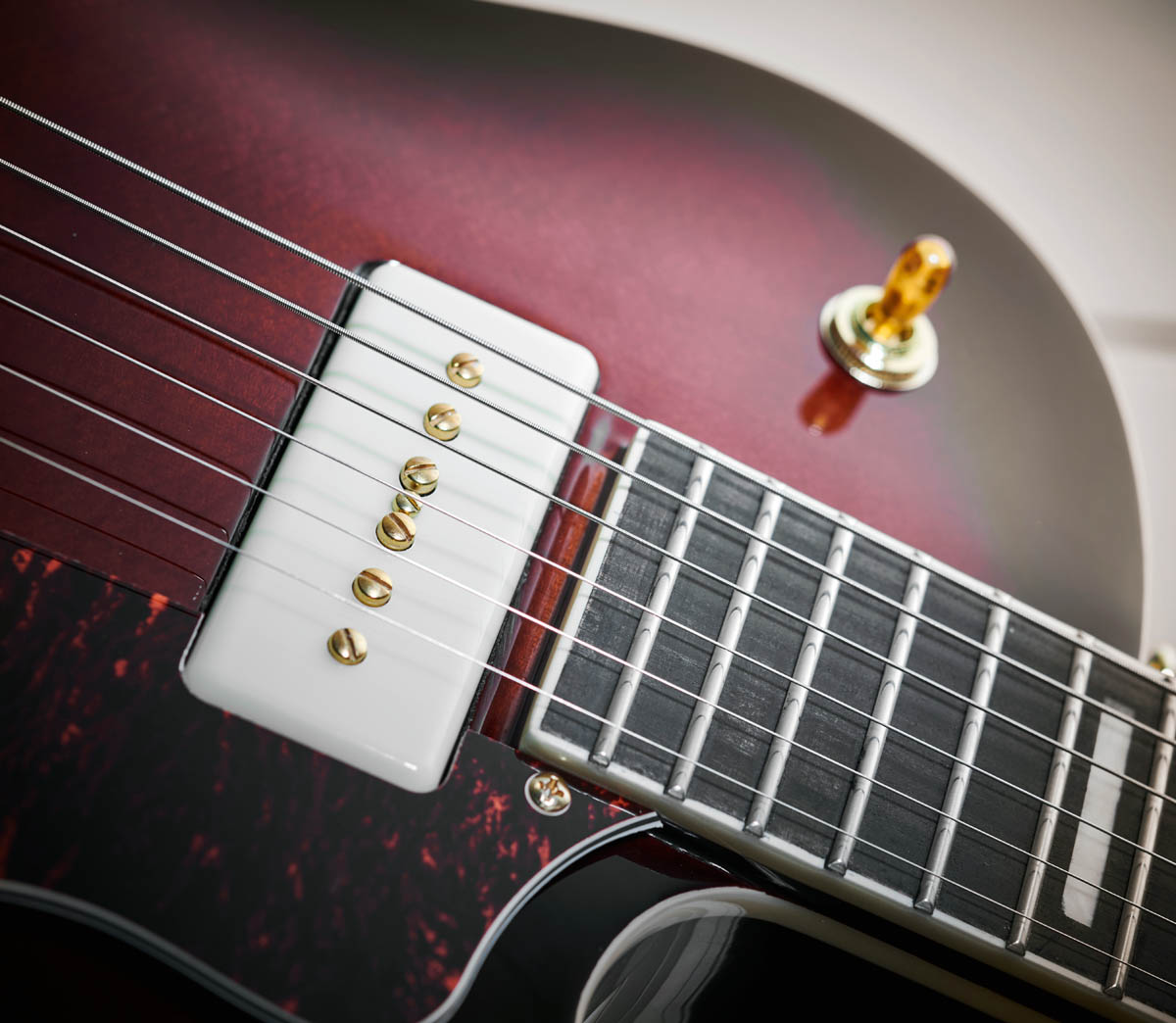
These Franz soapbar single coils mount to the guitar in a different fashion to a regular Gibson P-90.
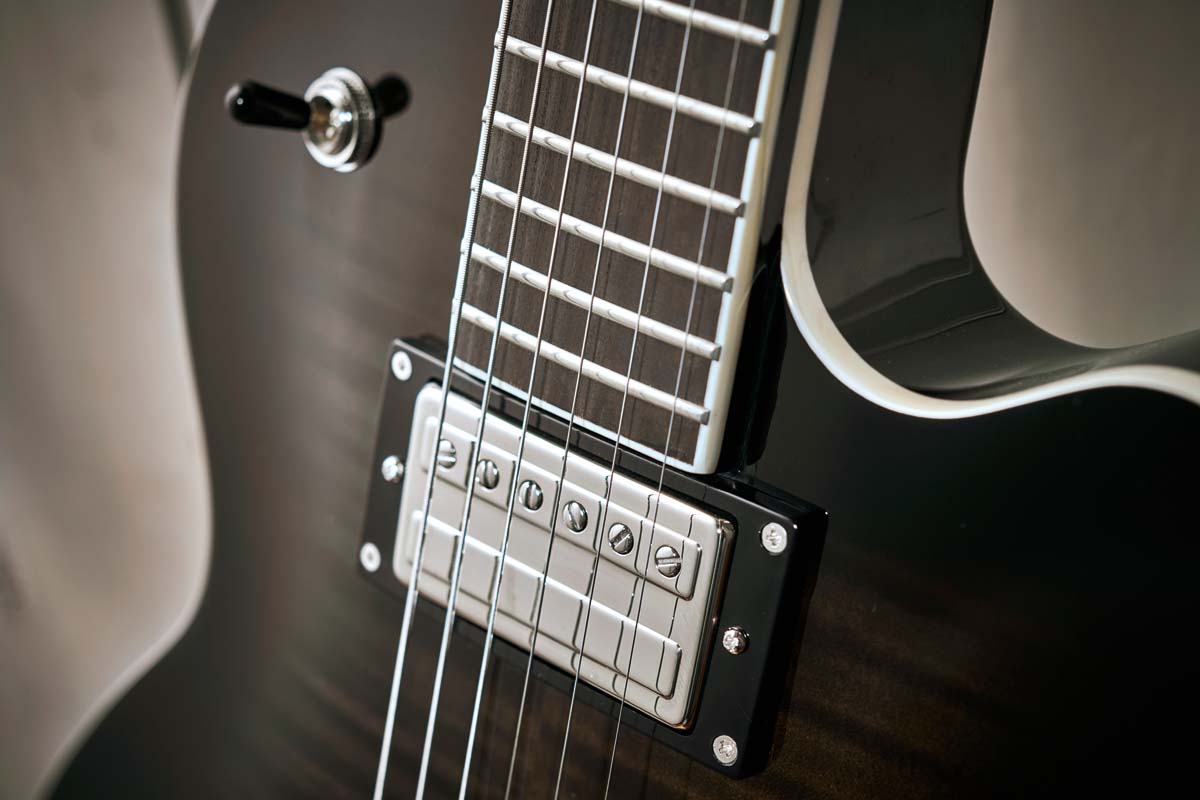
The P90 comes in Vintage Sunburst, and the top’s bursting is very subtle – it looks more like a deep mahogany brown, pretty much the colour of the back, sides and neck, too.
As well as an opaque Snow Crest White option, our HH model comes in Trans Black Burst and has a figured maple veneer top, hinting at a more contemporary style.
Aside from the top, though, the rest of the guitar is opaque black. Hidden under these sombre but classy-looking glossy colours, the construction is all mahogany aside from that flame maple veneer.
Of course, it’s the weight that gives the game away, even if you’re wearing a blindfold. Our reference M-75 weighs in at just 2.46kg (5.4lb), while the P90 here is 3.45kg (7.59lb) and the HH a shade heavier at 3.52kg (7.74lb), reflecting the ‘chambered’ rather than hollow construction.
P-90-style single coils can polarise opinion, but on the right guitar and in the right song they can be glorious, especially for those of us after a rootsy, rawer voice
What do we mean by chambered? Our new ’Crats start out with a solid chunk of mahogany that is routed out leaving the central section solid with plenty of air in the wings. You can easily see that if you peer into the rear control cavity of either, and you can also see that the separate top is mahogany, too.
In fact, this chambered construction style here is closer to the Newark St Bluesbird, although both new models retain the depth of the M-75: 50mm at the rim with an overall depth of approximately 60mm. The Bluesbird is slimmer: 40mm at the rim and 49mm overall.
The actual Guild legend with its Chesterfield logo on the headstock appears to be simply silk-screened metallic paint in certain lights: gold on the P90 and silver on the HH to match the hardware’s plating. But move either in the light and they become more pearlescent, rather like one of those metallic-looking stamps on a bank note.
The back of the headstock bears a simple GY-prefixed serial number with peel-off compliance and ‘Made in China’ stickers; our older M-75 has a KSG-prefixed serial number and ‘Handcrafted in Korea’ legend underneath.
A final identifier is simply the maple stripe down the back of the M-75’s neck; you don’t see that through the slightly translucent finish of the P90 model, but you can clearly see the headstock splice and the additional heel stack.
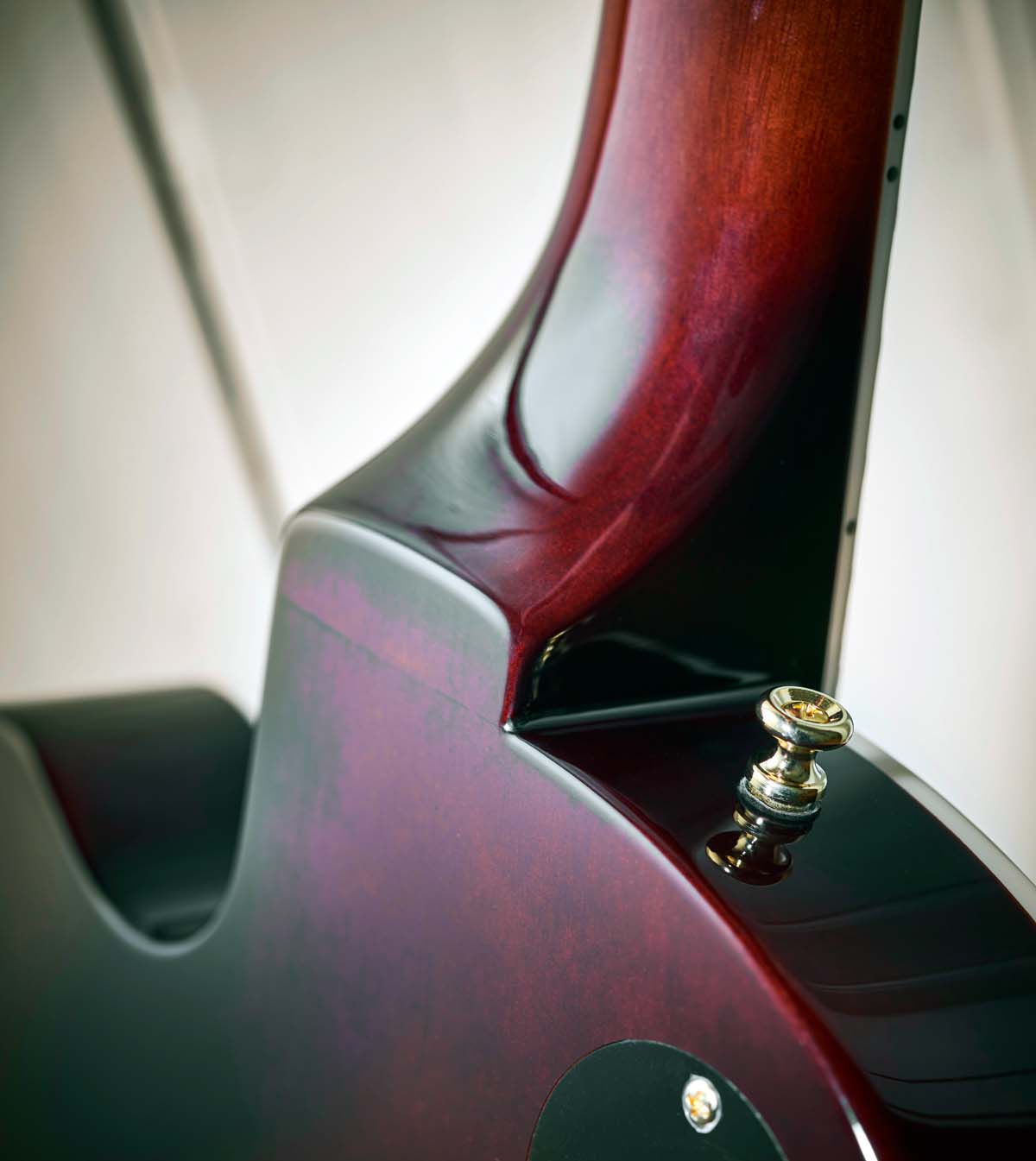
A typical Guild feature is this squared heel, which you’ll also see on the hollowbody M-75 Aristocrat.
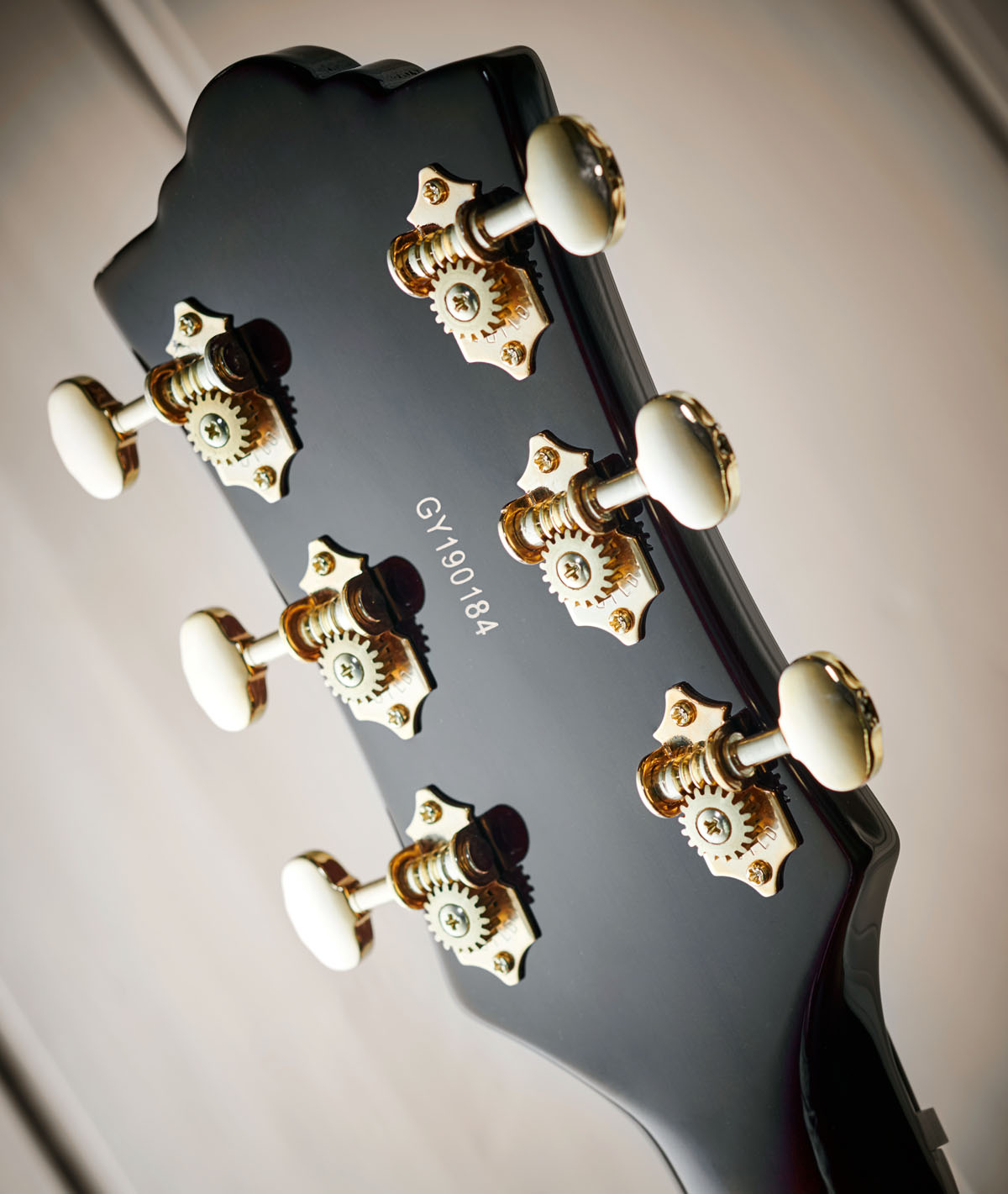
Tuners on both guitars are simple, open-backed and in the style of Grover Sta-Tite but have a Guild logo and metal ‘butterbean’ buttons.
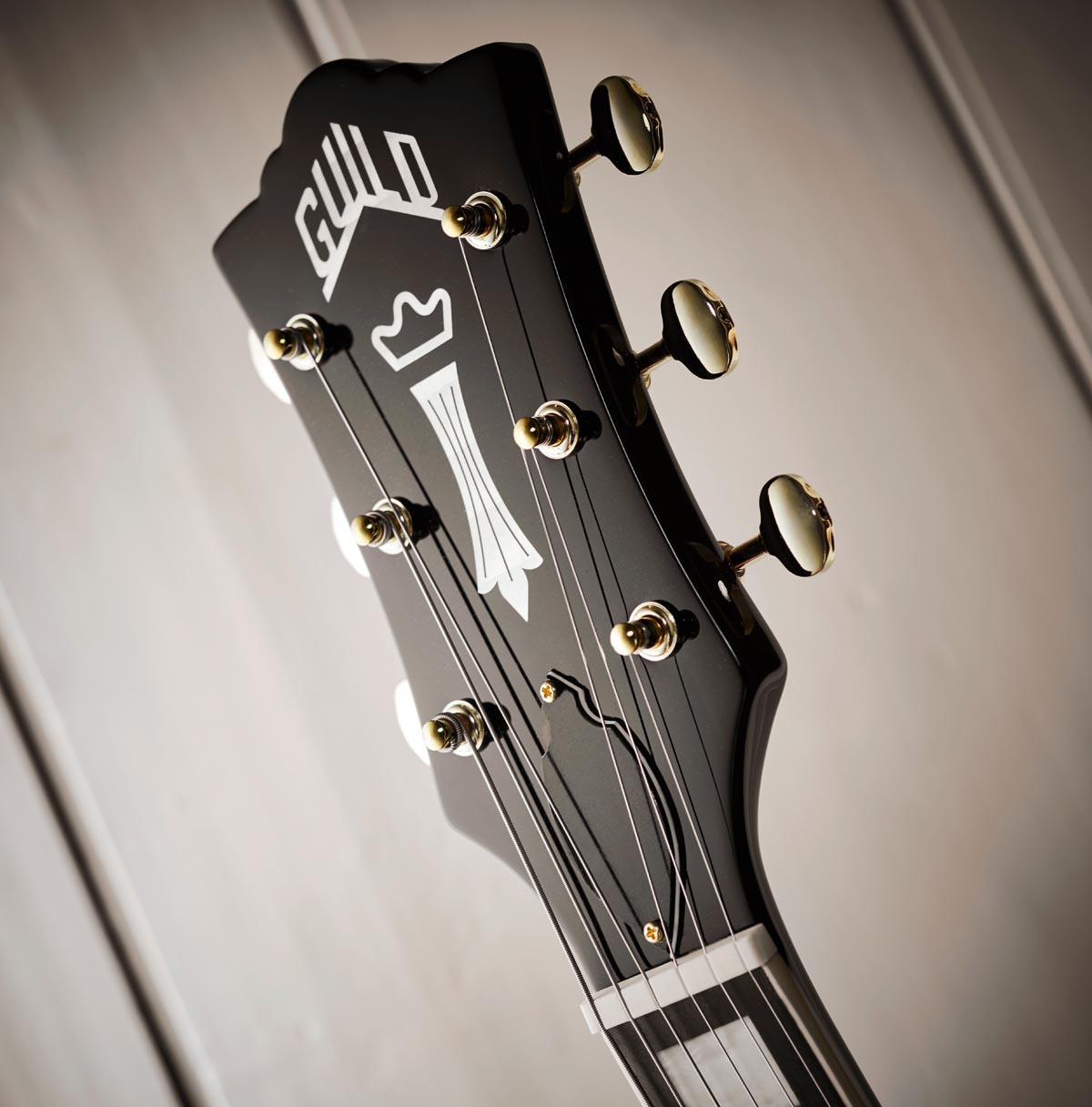
Guild’s elegant headstock with its ‘Chesterfield’ logo. The top nuts on both guitars on review are bone.
On closer inspection, the specs differ further with a flatter 305mm (12-inch) fingerboard radius on these new models as opposed to the slightly more rounded 240mm (9.5-inch) radius of the M-75.
Hardware is identical across both the new models, the obvious exception being the plating: gold on the P90, nickel on the Trans Black Burst HH (although, just to confuse things, its Snow Crest White option comes with gold hardware).
Strapping on either feels great: the beefy bulk of a Les Paul but without the tonnage
Their tuners are simple, open-backed and Grover Sta-Tite in style but have a Guild logo and metal ‘butterbean’ buttons; the tune-o-matic bridge mounts into ferrules inset into the top.
Again, this differs from the M-75 model: its tune-o-matic style bridge actually sits on metal feet and ‘floats’ (although we understand later models are pinned), more like an unpinned archtop bridge, while its tuners are stamped Grover with oval metal buttons.
Feel & Sounds
While that earlier M-75 is extremely light and feels it on a strap, both these new chambered Aristocrats feel much more Les Paul-like – although you’ll struggle to find ones in this weight range. Strapping on either feels great: the beefy bulk of a Les Paul but without the tonnage.
But the combination of the chambering and that harp tailpiece give them a different response even before you plug in – a little more semi-like and acoustic-y than an all-solid single-cut with a stud tailpiece but noticeably less acoustic-like than the hollow M-75.
The neck profiles are nicely done if a little generic-feeling: a perfectly good C that’s thinner in depth at the 1st fret, 21mm, than it actually feels, filling out to 23.3mm by the 10th fret and, in typical Guild style, the heel feels quite square and consequently a little bulky in higher positions.
The frets are pretty beefy but not overly high (approximately 2.73 by 1.08mm) and sit over the binding, which is slightly edge-rounded. Pretty tidy stuff.
P-90-style single coils can polarise opinion, but on the right guitar and in the right song they can be glorious, especially for those of us after a rootsy, rawer voice. Yes, they hum (the mix here is hum-cancelling, though) and these don’t sound or feel heavily potted at all. It’s an airy voice, spiky, punky at the bridge, thicker at the neck (and a little louder), but above all unrefined… and that’s a compliment.
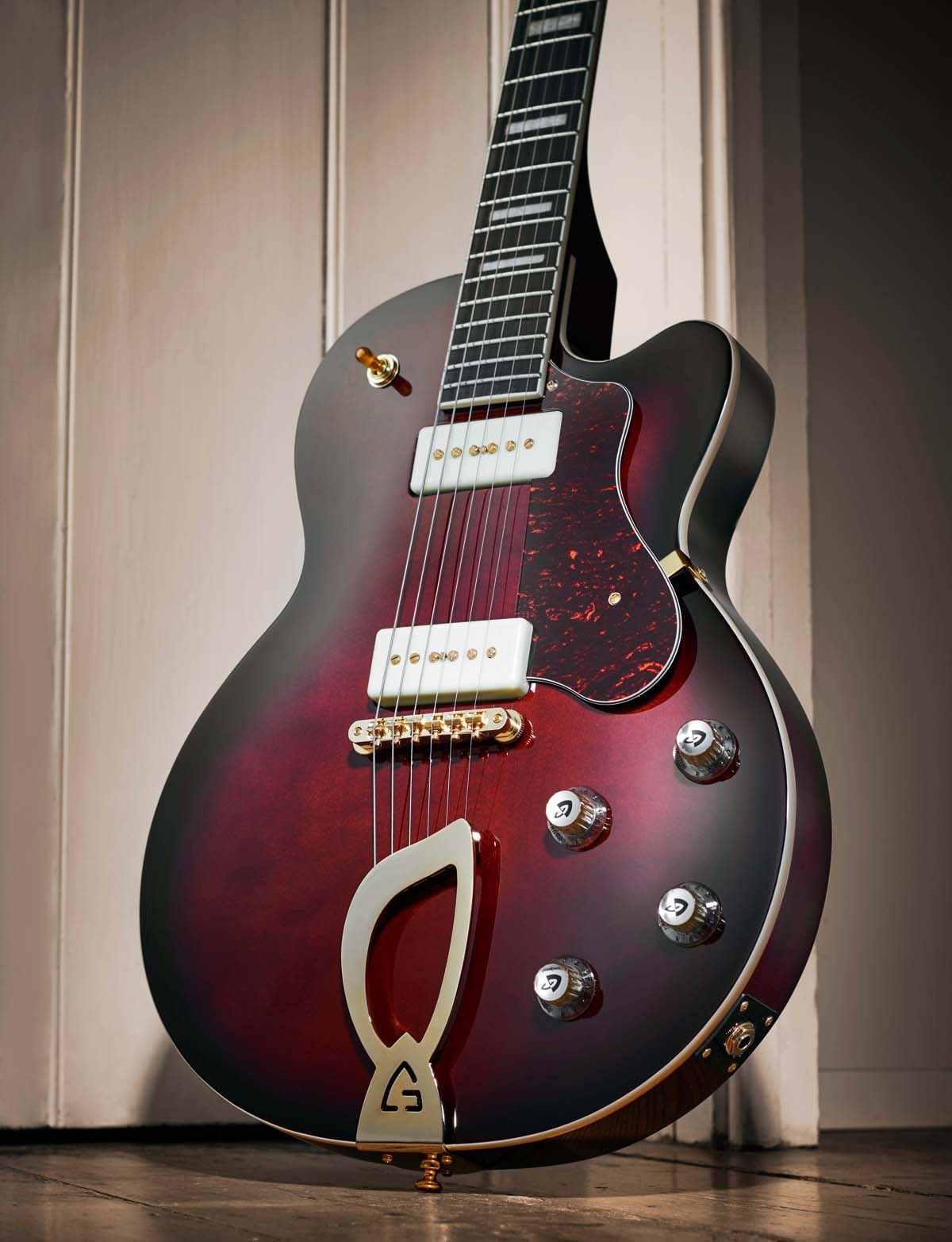
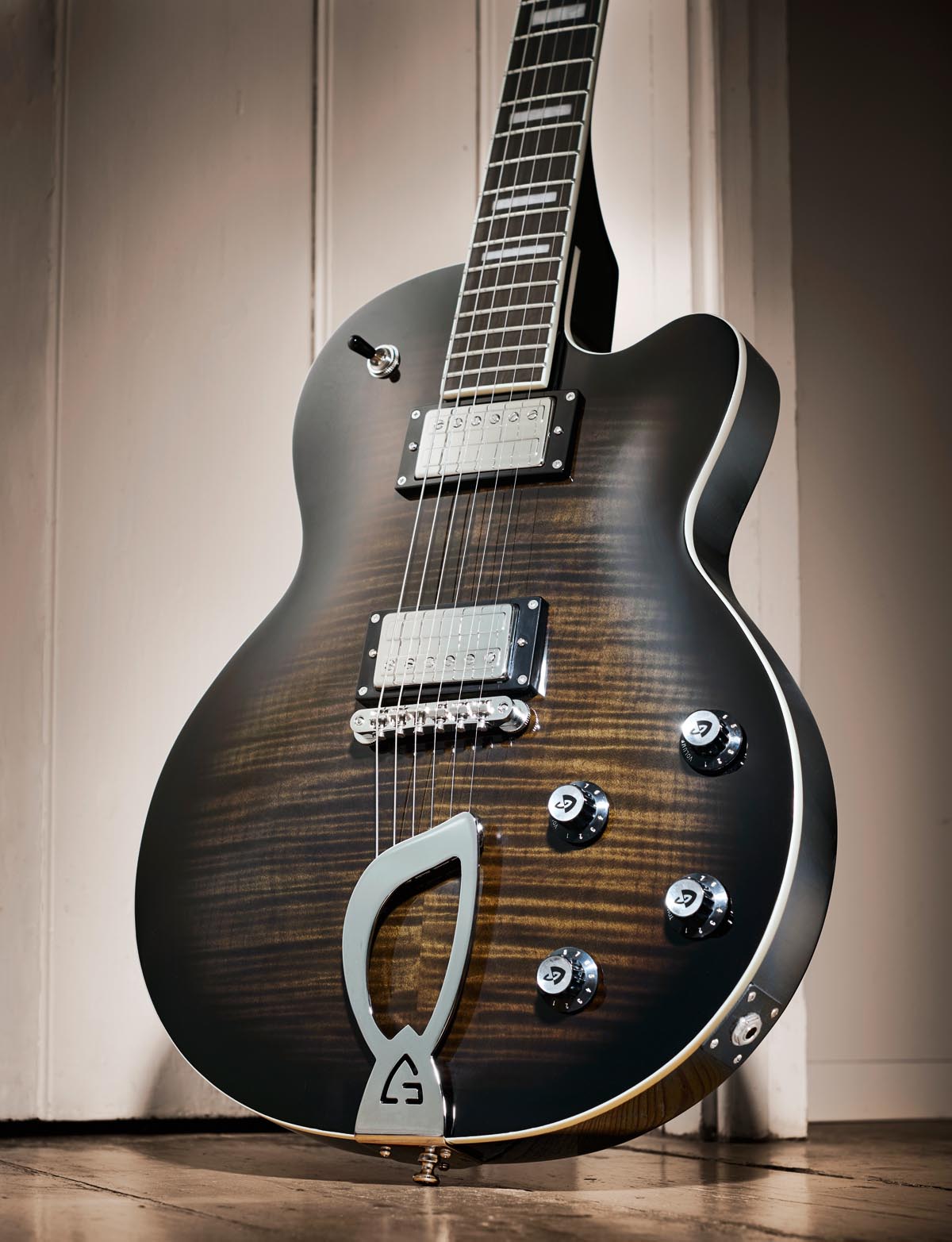
The HH actually sounds a little polite by comparison in humbucking mode – smoother but still with some spike and life. The splits do thin things out considerably, but dial in a little level boost and you’re certainly in the ballpark if you like your single-cuts cleaner and brighter, particularly on the neck pickup.
In mix position, voicing the neck split with the full bridge cleans things up a little, too. These HB-2s don’t capture the power of the real thing when we plug in our 1976 Guild S-90, but with some pedal/amp adjustment that raw, bright-edged voice is almost there.
Either way, both sit in the lower-output category compared with something like Gibson’s Burstbucker 1 and 2s on our modded 2019 Les Paul Classic.
The Newark St Collection offers considerable style, particularly if you dare to be a bit different
Using both models for an ongoing recording project, however, reveals just how good ‘cheap’ guitars have become. Straight out of the boxes the setups are good, the guitars are in tune and stable, and while both would benefit from a little fine-tuning it’s not a necessity.
Some hours later the tracks sound good and we’ve formed quite an attachment to the P90. The HH is little different – used for some cleaner parts and overdubs, and chasing a more hollow Gretsch-y voice, it really delivered, especially that split neck and full bridge mix.
Verdict
It’s fair to say that Guild has struggled to gain market share against more obvious classic brands. Even back in the day it was the guitar you played until you could afford a Gibson. That past perception is impossible to change, but the Newark St Collection offers considerable style, particularly if you dare to be a bit different.
And ‘a bit different’ sums up these two well-priced single-cuts, which move away from the original ‘midget’ jazz hollowbody M-75 Aristocrat to a contemporary voice that’s as at home with 60s hipsters as it is with much rockier and even heavier styles.
From a practical point, the good weights here mean we have a pair of single-cuts that won’t bother you on a long set, and straight from the shipping boxes they were ready to go.
Of course, it’s a combination of all their parts that result in what we hear – and that’s a subtly different texture and sound compared with more generic singlecuts. There’s character in spades and some vintage-styled class, all at a very tempting price.
Specs
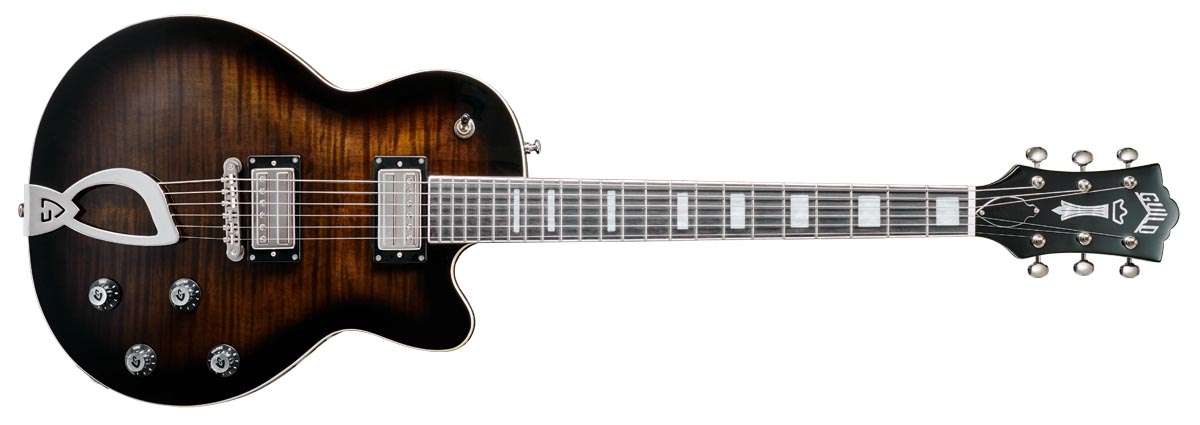
- PRICE: $799 / £795
- ORIGIN: China
- TYPE: Single-cutaway chambered body electric
- BODY: Chambered mahogany with carved figured maple (veneer) top
- NECK: Mahogany (3-piece), ‘C’ profile, glued-in
- SCALE LENGTH: 629mm (24.75”)
- NUT/WIDTH: Bone/43mm
- FINGERBOARD: Bound pau ferro, pearloid block inlays, 305mm (12”) radius
- FRETS: 22, medium jumbo
- HARDWARE: Nickel-plated tune-omatic-style bridge with harp tailpiece, vintage-style open-gear tuners with ‘butterbean’ buttons
- STRING SPACING, BRIDGE: 52.5mm
- ELECTRICS: Guild HB-2 humbuckers with nickel covers, 3-way toggle pickup selector switch, individual pickup volume (with pull/push coil-splits) and tone controls
- WEIGHT (kg/lb): 3.52/7.74
- OPTIONS: See Aristocrat P-90
- LEFT-HANDERS: No
- FINISHES: Trans Black Burst (as reviewed) and Snow Crest White with gold hardware – all gloss polyester
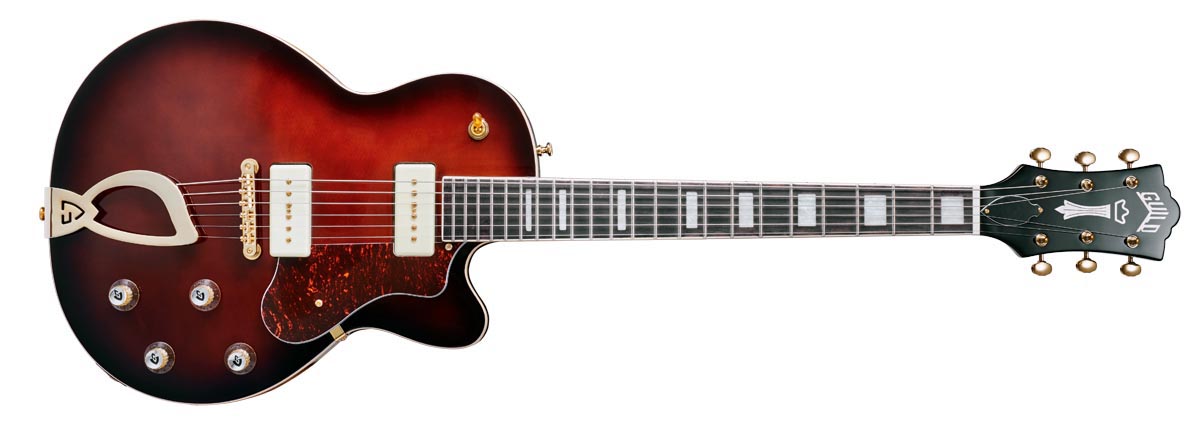
- PRICE: $799 / £795
- ORIGIN: China
- TYPE: Single-cutaway chambered body electric
- BODY: Chambered mahogany with carved figured maple (veneer) top
- NECK: Mahogany (3-piece), ‘C’ profile, glued-in
- SCALE LENGTH: 629mm (24.75”)
- NUT/WIDTH: Bone/43mm
- FINGERBOARD: Bound pau ferro, pearloid block inlays, 305mm (12”) radius
- FRETS: 22, medium jumbo
- HARDWARE: Nickel-plated tune-omatic-style bridge with harp tailpiece, vintage-style open-gear tuners with ‘butterbean’ buttons
- STRING SPACING, BRIDGE: 52.5mm
- ELECTRICS: Guild Franz P90 soapbar single coils, 3-way toggle switch, individual pickup volume and tone controls
- WEIGHT (kg/lb): 3.45/7.59
- OPTIONS: See Aristocrat HH
- LEFT-HANDERS: No
- FINISHES: Vintage Sunburst (as reviewed)
- CONTACT: Guild Guitars

Dave Burrluck is one of the world’s most experienced guitar journalists, who started writing back in the '80s for International Musician and Recording World, co-founded The Guitar Magazine and has been the Gear Reviews Editor of Guitarist magazine for the past two decades. Along the way, Dave has been the sole author of The PRS Guitar Book and The Player's Guide to Guitar Maintenance as well as contributing to numerous other books on the electric guitar. Dave is an active gigging and recording musician and still finds time to make, repair and mod guitars, not least for Guitarist’s The Mod Squad.
“It holds its own purely as a playable guitar. It’s really cool for the traveling musician – you can bring it on a flight and it fits beneath the seat”: Why Steve Stevens put his name to a foldable guitar
“Finely tuned instruments with effortless playability and one of the best vibratos there is”: PRS Standard 24 Satin and S2 Standard 24 Satin review











